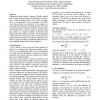Free Online Productivity Tools
i2Speak
i2Symbol
i2OCR
iTex2Img
iWeb2Print
iWeb2Shot
i2Type
iPdf2Split
iPdf2Merge
i2Bopomofo
i2Arabic
i2Style
i2Image
i2PDF
iLatex2Rtf
Sci2ools
ICARCV
2002
IEEE
2002
IEEE
LTSD: a highly efficient symmetry-based robust estimator
Although the least median of squares (LMedS) method and the least trimmed squares (LTS) method are said to have a high breakdown point (50%), they can break down at unexpectedly lower percentages of outliers when those outliers are clustered. In this paper, we investigate the breakdown of LMedS and the LTS when a large percentage of clustered outliers exist in the data. We introduce the concept of symmetry distance (SD) and propose an improved method, called the least trimmed symmetry distance (LTSD). The experimental results show the LTSD gives better results than the LMedS method and the LTS method particularly when there is a large percentage of clustered outliers and/or a large standard variance in the inlier population.
| Added | 14 Jul 2010 |
| Updated | 14 Jul 2010 |
| Type | Conference |
| Year | 2002 |
| Where | ICARCV |
| Authors | Hanzi Wang, David Suter |
Comments (0)

